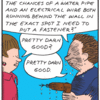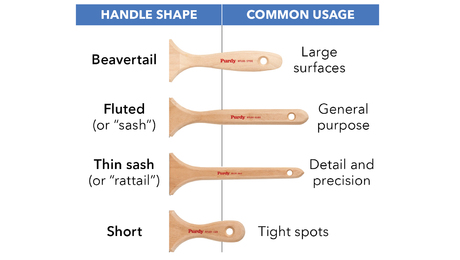I am wondering if any of the pro’s have run across this technic and if it was acceptable in it’s day.
The house was built in the mid 50’s. My guess is that it was well wired for it’s time. For example the kitchen was feed by two different 20 amp branch circuits (although they also feed other areas).
But over the years there have been many, not so well done changes (too wires under screws. CCW, hidden box, and hidden flying splices, switched neutrals, etc).
Anyway I think that this might have been orginal. It was too neatly done. There was a box in the basement ceiling with a fixture. It was also the junction for the feed from the main pannel and then it split off to two branches to other runs.
One the one run the wire was left long and installtion was stripped off about 6″ from the end for about 1″. Then instulation was stripped off at the end forming a pigtail for the light fixture connection. The two other run where normal length and they where wrapped side by side around the main run.What was unusual was that the main run wire was not deformed and the branch wires around it was tight and smooth.
For those familar with wire-wrap it looked like that. However wire-wrap uses small wire (#28-30) around a post. And the post is short so that you can get the tool over it. This was 12 guage wrapped around 12 guage.
This is was taped. No solder. It appeared to be in good shape, no signs of heating or arcing.




















Replies
No idea if it was ever legal anywhere, but have seen houses like that too - one was even built in about 1974. Old K&T allowed wrapping without solder I recall, rubber tape followed by friction tape insulation - someone likely has a 1927 NEC copy?
sidelight on wire wrapping - the high reliability electronic wire wraps are on gold plated square posts - with that caveat throw in, reliability specs (e.g. Mil-std-217) rate wire wrap as the HIGHEST reliability connection method, even better than welding*, crimping, or soldering, primarily due to errors in those methods during assy.
At least one commercial satellite that I know of had an extensive last minute circuit upgrade done by wirewrap.
* think ion-beam welding is slightly better
Years and years ago I was give some Bell lab tech journals from the 50's. I think that is where I first saw wire-wrap. They have a number of test including microscopic views of the juntions. They where gas tight and "maybe" (don't remember the details) there was some "forging" between the post and the wire. And with maybe 50 different points of contact as least a couple had to be good.
I had a similar thing done in my house. When wiring two duplex outlets side by side, the same technique was used to strip 1" of insulation 6" from the end and this bare spot was wrapped around the first duplexes' screw, then the end was used to feed the second duplex outlet. Does anyone know if that technique is now code-approved? I changed it in one box, left the other one alone.
that technique is as old as the telegraph lines. I'm thinking it may go back as far as the 1800s. While obsolete and massively time consuming the basic technique is sound.
This sounds like it may have been done by someone with electrical experience, military or radio club, but not an electrician by todays standards. The insulation method was commonly rubber tape followed by friction tape to hold everything together.
I will couch this a bit as I have seen some joints made up and soldered in a similar manner. For some reason, oxidation or overheating maybe, where the solder was visible only when viewed at very close range with good light. It looked like they were just wrapped but had been soldered so your situation may be similar. This is confused even more because many early rubber insulated wires had tinned , covered with a coat of solder, copper conductors to protect the base wire from the sulfur in the rubber.
Bill,
You've described a tap splice, I think. See the attached scan, from a 1913 book, "Electrical Maintenance and Repair, Handbook of Electrical methods", compiled from Electrical World (a magazine, I assume), published by McGraw-Hill.
Strong mechanical splices like the tap splice and the western union splice were used by telegraph linemen, first on iron wires, then for copper. In residential wiring, the electrician made the splice, then either used a pot of molten lead into which he dipped the splices, or an alcohol blowtorch, to solder them. Then it was several wraps of rubber tape, then wraps of friction tape. If done correctly, a tap or WU splice was as good a connection as you could ever get. If your splice wasn't soldered (and in some cases, there wasn't a lot of excess solder visible), then it wasn't done to the standard of the day. Not that it's dangerous--I mean, we don't solder splices now, and some people don't eve pre-twist the wires before spinning on a wirenut. I think a really tight tap or WU splice, well-wrapped with tape, would be O.K.
Ben,
The technique you describe is another oldie but goodie. A man I worked with several years ago used it to feed power to switches in multi-gang boxes. He'd take a piece of wire and strip about an inch of insulation off for each switch, about 6" apart along the length. He used a knife and sliced like he was sharpeneing a pencil. Then he'd wrap each bare section around the terminal screw of a switch (forming a "U" shape). One end was left long, of course, to connect to the hot wire in the box.
It made the switches into sort of an accordian, all hooked together. He could do this pretty fast, but nobody else on the crew had the patience to do it that way. So we'd just make a splice with one pigtail for each switch. I think the "loop through" approach was used in the old days because it avoided making a fat splice with three or four wires. That would have been a pain to heat up to solder, and the primitive wire nuts (porcelin with no wire spring in 'em) weren't trusted by the guys that were used to soldering everything. One drawback, if you needed to change out a switch (except the one at the free end), you had to take 'em all out.
BTW, this fellow Nick was about 70 when we worked together, 'bout nine years ago, and he'd started in the trade doing knob and tube wiring around 1940. Spent WWII in the South Pacific, USMC rifleman, saw heavy duty. Neat guy, always willing to explain things.
Cliff
Yes, I was familar with the basic technic. I think that I have seen that same picture in my fathers old books from the 30's.
But I had heard of it being used for interior wiring except maybe K&T.
But there was no solder.
But what really amazed me was that this was on the end of a run. All of the samples that I have seen where they do this it was done on with a main wire that was tensioned. In this case they must have used a 2nd person with a pair of pliers to hold the main wire tight while they twisted the other around it. As there was no sign of any twisting or distortion on the main run.
I had to remove one of the branches so I just cut it out and wire nutted it the remaining and this weekend I will be replacing the main run with a new one back to the pannel.
I memt to save the splices that I cut out so that I could undo them, but they got sweep up with the other trash.
Hi bill.
As a former project manager of a manufactured home development. I have seen all the manufactered homes two gang switches wired in a similar fashion. These homes are from various manufacturers so it is done commonly in this type of home. The only difference is the splices are wire nutted together. But all the line conductors would have the insulation stripped off at two to three inch intervals and would then be wrapped around the line side of the switches.